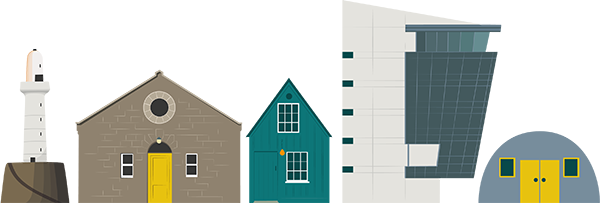Membership of the Fittie Community Development Trust
The Fittie Community Development Trust (FCDT) is a registered charitable organisation composed of residents of the Footdee Conservation Area, Aberdeen. We are registered as Scottish Charitable Incorporated Organisation (SCIO) number 46775. The Trust was established to support and promote the social, economic and environmental development of the Footdee area of Aberdeen. Our principal aims are to secure and develop a community hub for the benefit of residents and visitors in the area, to enable the development of common interests, improve community cohesion, enhance the social wellbeing of the residents and enhance the historical and cultural fabric of the
village.
The purpose of the Fittie Community Development Trust is to manage and maintain a community hall for the benefit of the residents of the village of Footdee and its environs, without distinction of age, gender, sexuality or political, religious and other opinions, in order to improve the conditions of life within the community:
- By providing facilities for recreational, cultural, and community-centred activities, and
- By sponsoring community events within the hall to advance education, citizenship and community development.
The hall would be owned by the Trust on behalf of the community. The Trust consists of:
- Full Members – who have the right to attend any general meetings and have important powers under the constitution. In particular, the members elect charity trustees from the membership to serve on the board, which is
accountable to the members for its actions. They also take decisions on changes to the constitution itself. - Associated – who, although unable to vote, can attend any general meetings and will have opportunity to voice opinions and ideas.
- The Board – This comprises of Charity Trustees who hold regular meetings to manage the activities of the Trust. For example, the board is responsible for monitoring and controlling the financial position of the trust.
The rules governing the operation of the Trust are detailed in the constitution, a copy of which is available on request and which can be read on our website.
The members have a clear and fundamental role, akin to that of shareholders within a company, but they have no liability to pay any sums to help to meet the debts (or other liabilities) of the trust in the event of dissolution. Accordingly, if the trust is unable to meet its debts, the members will not be held responsible.
To ensure the continued viability of the Trust and the long term future of the hall it is important that the community is fully engaged with the Trust and its operations, and is represented by as wide and diverse a membership as possible. Accordingly, Full Membership of the Trust is open to any individual aged 16 and residing in the Footdee Conservation Area, bounded by the River Dee to the south, the Beach Esplanade to the north, Pocra Quay to the west and the beach to the east.
The Secretary must keep a register of members, setting out for each current member his/her full name and address and the date on which he/she was registered as a member of the organisation.
To enable the maintenance of this register, we ask that any person who wishes to become a member completes an application form and sends it to a member of the Board for action.
As stated, the members have a clear and fundamental role within the trust, akin to that of shareholders within a company. This mainly involves attending members’ meetings.
A member may also support the Trust by volunteering on a sub-committee for a specific activity.
Members’ meetings
The Board must arrange a meeting of members -an annual general meeting or “AGM”- in each calendar year.
The business of each AGM must include:
- a report by the Chairperson on the activities of the organisation
- consideration of the annual accounts of the organisation
- the election/re-election of charity trustees.
- The Board may arrange a special members’ meeting (a special general meeting or “SGM”) to consider specified resolutions at any time. The board must also arrange an SGM if it is requested to do so by a sufficient number of members (25% or more of the total membership of the organisation).
Voting
Every member has one vote, which must be given in person. Most decisions at members’ meetings will be made by majority vote, but the following resolutions will be valid only if passed by not less than two thirds of those voting:
- a resolution amending the constitution
- a resolution expelling a person from membership
- a resolution directing the board to take any particular step (or directing the board not to take any particular step)
- a resolution approving the amalgamation of the organisation with another SCIO (or approving the constitution of the new SCIO to be constituted as the successor pursuant to that amalgamation)
- a resolution to the effect that all of the organisation’s property, rights and liabilities should be transferred to another SCIO (or agreeing to the transfer from another SCIO of all of its property, rights and liabilities)
- a resolution for the ‘winding up’ or dissolution of the organisation.

